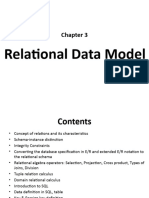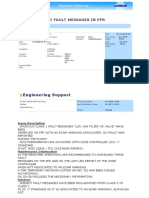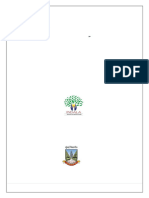Intro To
Uploaded by
dmfrancisco2400Intro To
Uploaded by
dmfrancisco2400Optimizing Library Resources: A Unified Web-Based Management Solution
Introduction
Libraries play a crucial role in providing access to information and knowledge to individuals and
communities. With the advancement of technology, there is a growing need to optimize library
resources to meet the evolving needs of users. The study "Optimizing Library Resources: A Unified Web-
Based Management Solution" aims to address this need by developing and implementing a centralized
web-based system for managing library resources. Several studies both foreign and local have explored
various aspects of library resource optimization, providing valuable insights into this topic.
Foreign Studies:
1. Smith et al. (2018) conducted a study on the implementation of web-based library management
systems in public libraries in the United States. They found that these systems improved efficiency in
resource allocation and enhanced user satisfaction.
2. Johnson and Brown (2019) investigated the impact of digital resource management systems on
academic libraries in Europe. Their study revealed that these systems facilitated better access to
electronic resources and streamlined library workflows.
3. Chen et al. (2020) explored the role of data analytics in optimizing library collections in libraries across
Asia. Their findings demonstrated that data-driven decision-making led to more effective resource
allocation and improved user experiences.
Objectives
The main objective is to develop and implement a unified web-based management solution for libraries.
Specifically, the study aims to:
1. Streamline library operations such as cataloging, circulation, and resource acquisition.
2. Enhance accessibility and user experience through remote access to resources.
2.1 Improve search functionalities for easier resource discovery.
2.2 Implement user-friendly interfaces for seamless navigation.
2.3 Provide mobile-friendly access for on-the-go users.
3. Foster collaboration among library staff through a centralized platform.
4. Incorporate data analytics capabilities for informed decision-making.
5. Modernize library services to meet the needs of the digital age.
Scope and Delimitations
The scope of the study includes the design, development, testing, and implementation phases of the
unified web-based management solution. It encompasses various library functions such as cataloging,
circulation, patron management, and resource acquisition. However, the study does not address
hardware infrastructure requirements, extensive staff training, financial aspects, legal considerations,
broader organizational changes, third-party integrations, customization beyond basic localization, and
long-term sustainability or scalability considerations beyond initial deployment.
Significance of the Study
The significance of the study lies in its potential to transform libraries into more efficient, accessible, and
user-centric institutions. By developing and implementing a unified web-based management solution,
libraries can optimize resource allocation, improve user experiences, foster collaboration among staff,
and make informed decisions based on data analytics. This study contributes to the advancement of
library science and practice, ensuring that libraries remain relevant and responsive to the needs of users
in the digital age.
You might also like
- Serving Scholars, Empowering Minds: A Practical Guide to College Librarianship CareersFrom EverandServing Scholars, Empowering Minds: A Practical Guide to College Librarianship CareersNo ratings yet
- Research Data Management: Practical Strategies for Information ProfessionalsFrom EverandResearch Data Management: Practical Strategies for Information ProfessionalsJoyce M. RayNo ratings yet
- Making Institutional Repositories WorkFrom EverandMaking Institutional Repositories WorkBurton B. CallicottNo ratings yet
- Going Beyond the Shelves: Ground-Breaking Library Management StrategiesFrom EverandGoing Beyond the Shelves: Ground-Breaking Library Management StrategiesNo ratings yet
- Strategic Library Management: Leading, Innovating, and Succeeding in Public LibrariesFrom EverandStrategic Library Management: Leading, Innovating, and Succeeding in Public LibrariesNo ratings yet
- Transforming Acquisitions and Collection Services: Perspectives on Collaboration Within and Across LibrariesFrom EverandTransforming Acquisitions and Collection Services: Perspectives on Collaboration Within and Across LibrariesMichelle FlinchbaughNo ratings yet
- E-Library Management System: Project Proposal ForNo ratings yetE-Library Management System: Project Proposal For8 pages
- Citizen Science Skilling for Library Staff, Researchers, and the PublicFrom EverandCitizen Science Skilling for Library Staff, Researchers, and the PublicJitka Stilund HansenNo ratings yet
- 11.Project-Online Library Management SystemNo ratings yet11.Project-Online Library Management System28 pages
- Data Information Literacy: Librarians, Data and the Education of a New Generation of ResearchersFrom EverandData Information Literacy: Librarians, Data and the Education of a New Generation of ResearchersJake CarlsonNo ratings yet
- Group 7 - Web- Based Library Managements SytemNo ratings yetGroup 7 - Web- Based Library Managements Sytem70 pages
- Collective Intelligence and Digital Archives: Towards Knowledge EcosystemsFrom EverandCollective Intelligence and Digital Archives: Towards Knowledge EcosystemsNo ratings yet
- Megaproject Organization and Performance: The Myth and Political RealityFrom EverandMegaproject Organization and Performance: The Myth and Political RealityNo ratings yet
- A Library Management System Is A Software Application Created To Help A Library in Managing and Organizing MaterialsNo ratings yetA Library Management System Is A Software Application Created To Help A Library in Managing and Organizing Materials5 pages
- Project-Online Library Management SystemNo ratings yetProject-Online Library Management System27 pages
- Towards best practice in the Archetype Development ProcessFrom EverandTowards best practice in the Archetype Development ProcessNo ratings yet
- New Directions in Supply-Chain Management: Technology, Strategy, and ImplementationFrom EverandNew Directions in Supply-Chain Management: Technology, Strategy, and ImplementationNo ratings yet
- Chapter 3 - RELATIONAL DATA MODEL - Initial - Version1No ratings yetChapter 3 - RELATIONAL DATA MODEL - Initial - Version1113 pages
- Nudging Towards Responsible Recommendations A Graph-Based Approach To Mitigate Belief Filter BubblesNo ratings yetNudging Towards Responsible Recommendations A Graph-Based Approach To Mitigate Belief Filter Bubbles15 pages
- 20 Common Types of Computer Viruses and Other Malicious ProgramsNo ratings yet20 Common Types of Computer Viruses and Other Malicious Programs7 pages
- How To Dump and Repackage AGE DE For ModdingNo ratings yetHow To Dump and Repackage AGE DE For Modding3 pages
- CentOS 6 - DNS Server - Install - Configure BIND - Server WorldNo ratings yetCentOS 6 - DNS Server - Install - Configure BIND - Server World3 pages
- SkillDzire - Full Stack Java - Internship ContentNo ratings yetSkillDzire - Full Stack Java - Internship Content6 pages
- Sophisticated Sign Board Power Saving SystemNo ratings yetSophisticated Sign Board Power Saving System6 pages
- 01-Upload Purchase Order Data Using Multiple Flat FilesNo ratings yet01-Upload Purchase Order Data Using Multiple Flat Files27 pages
- SIM7070 - SIM7080 - SIM7090 Series - FS - Application Note - V1.02No ratings yetSIM7070 - SIM7080 - SIM7090 Series - FS - Application Note - V1.029 pages
- Aviat WTM 3300 Product Ordering Guide: All Outdoor E-Band Packet Microwave Radio SystemNo ratings yetAviat WTM 3300 Product Ordering Guide: All Outdoor E-Band Packet Microwave Radio System32 pages
- Comparative Study of Testing Tools Apache Jmeter and Load RunnerNo ratings yetComparative Study of Testing Tools Apache Jmeter and Load Runner17 pages

























































































